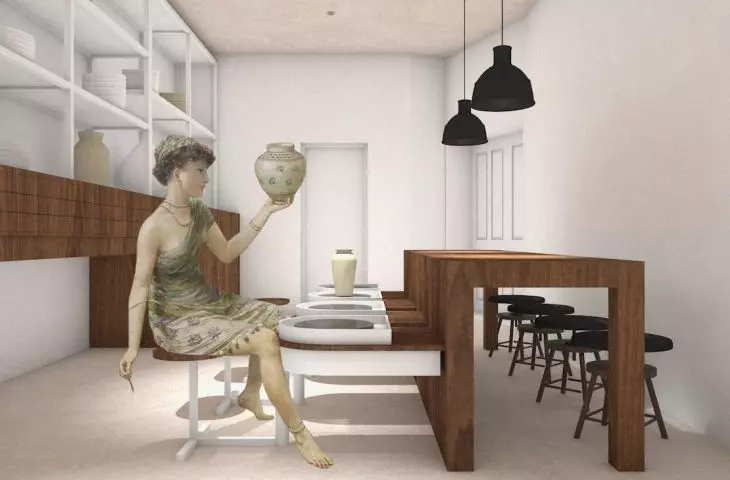The {tag:studenci} from the Higher School of Ecology and Management in Warsaw, following the growing interest in handicrafts, designed a ceramics studio where, in addition to buying unique products, visitors could take part in workshops. The interiors proposed by the author, kept in natural colors referring to the shades of clay, could be created on the first floor of a building on Ujazdowskie Avenue in Warsaw.
The presented concept was created as part of a semester assignment under the direction of Prof. Jerzy Boguslawski at the Interior Architecture Department of the Warsaw School of Ecology and Management. The challenge was to arrange the first floor of the building at 20 Ujazdowskie Avenue, whose total area was less than 100 square meters.
The design task was to arrange the first floor space of a building on Ujazdowskie Avenue
© Julia Rycerska
ceramics studio in Warsaw
Since interest in ceramics and handicrafts is now strongly growing, the main idea of my project was to create a creative space with a store, offering ceramic products and weekend workshops in this craft for children and adults. Warm and muted colors, wood and organic shapes - this is how I would describe the concept of the ceramics studio I proposed in a nutshell. I wanted to create a place that by its very arrangement and the materials used refers to its purpose, and with its minimalism will shift the attention of the viewer to what is most important - the ceramic products on display," explains Julia Rycerska.
The interior has been divided into two spaces. The first is the exhibition and store room, while the second is the studio, further divided into two rooms.
ceramics studio, projection
© Julia Rycerska
exhibition and store space
The author's inspiration for the design of the store space was clay and its "plastic possibilities." For this reason, the base of the concept is the display elements and the store counter with round and irregular shapes. The focal point here is the display wall behind the counter, with indentations of also rounded forms. The shelf near the wall was designed on the basis of a simple grid, so that it contrasts with the rest of the space and emphasizes the roundness of the main elements. The whole interior is complemented by led lighting of warm and atmospheric color, which shape matches the display blocks underneath.
The store space together with the oval exhibition blocks
© Julia Rycerska
The color scheme and materials also allude to the clay raw material. The main element is limestone with a beige, natural hue, with which the display forms are covered, and concrete on the floor with a mild and warm color - used to emphasize the rawness. Meanwhile, the introduction of wood adds a cozier atmosphere.
The ceramics studio is located in the second part of the designed space
© Julia Rycerska
ceramics studio
The second designed space is a ceramics studio, part of which is located on a small elevation, accessed by a staircase with an original wavy shape and a glass door. For functional reasons, the author divided the studio into two rooms. The first room is a place to work on potter's wheels, which have been matched with a large table. This space is also the place where workshops are to be held for those interested. A bookcase placed against the wall was designed by the student to accommodate finished products of various sizes, as well as containers for storing excess clay, so the space can operate in a zero waste style. The second room contains kilns for firing ceramics, a space for storing tools and a small office for working on new projects. Finally, behind the studio is a small bathroom, which also has a shower for the convenience of the workers.
The first room in the ceramics studio is a place to work on potter's wheels
© Julia Rycerska
Thanks to the studio's glass doors, visitors to the store have the opportunity to watch the artists at work on the products they plan to buy. This procedure is also intended to encourage customers to take part in the ceramics workshops that the place offers, the author adds.
Read also about the design of a three-generation house, in which authors Dominika Cieplak and Kamil Federyga proposed a large ceramics studio.


























